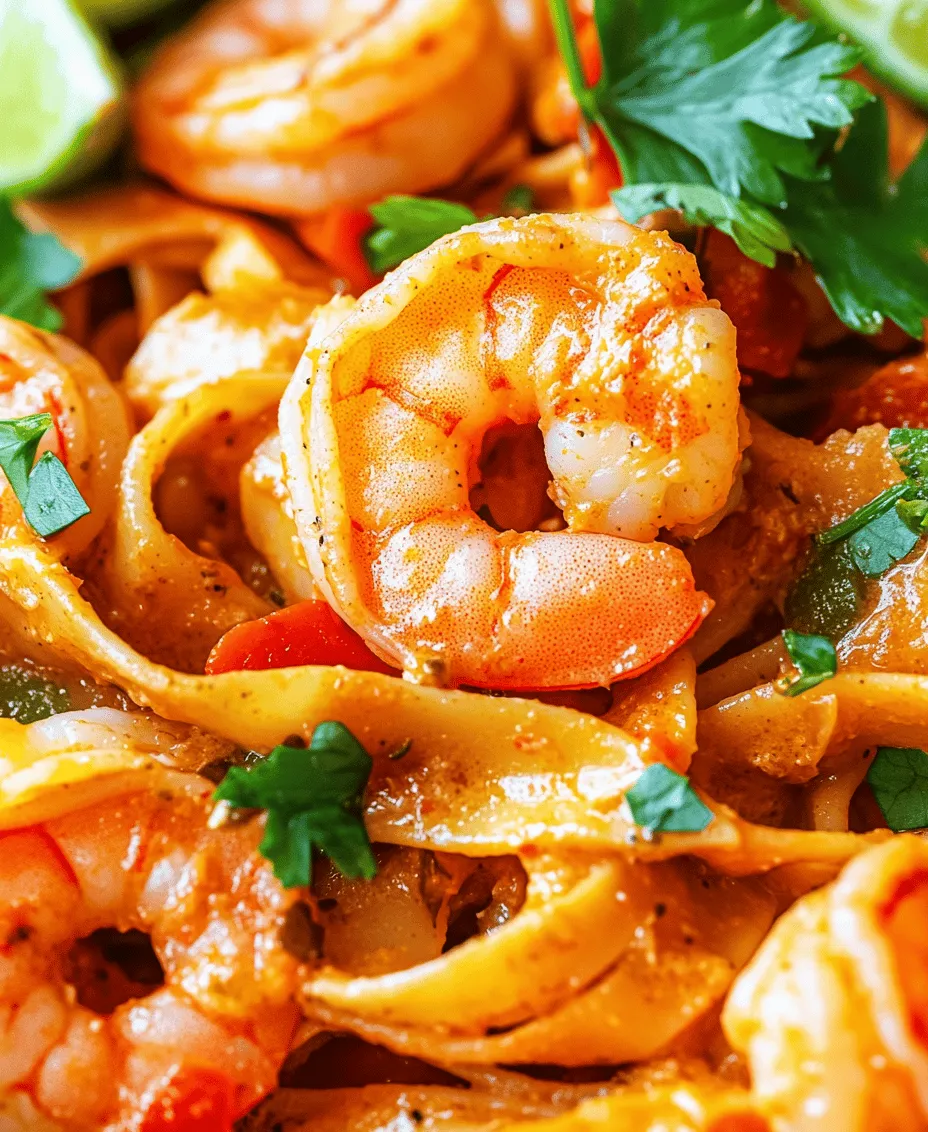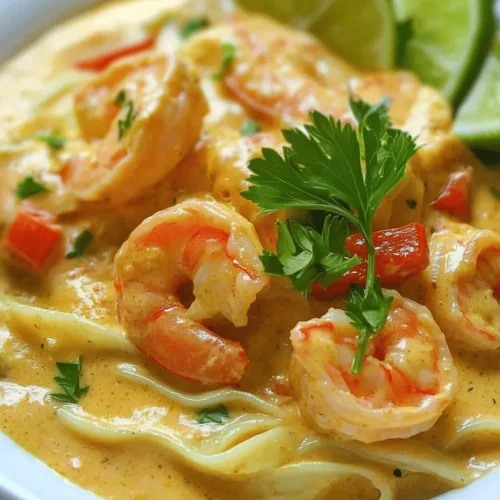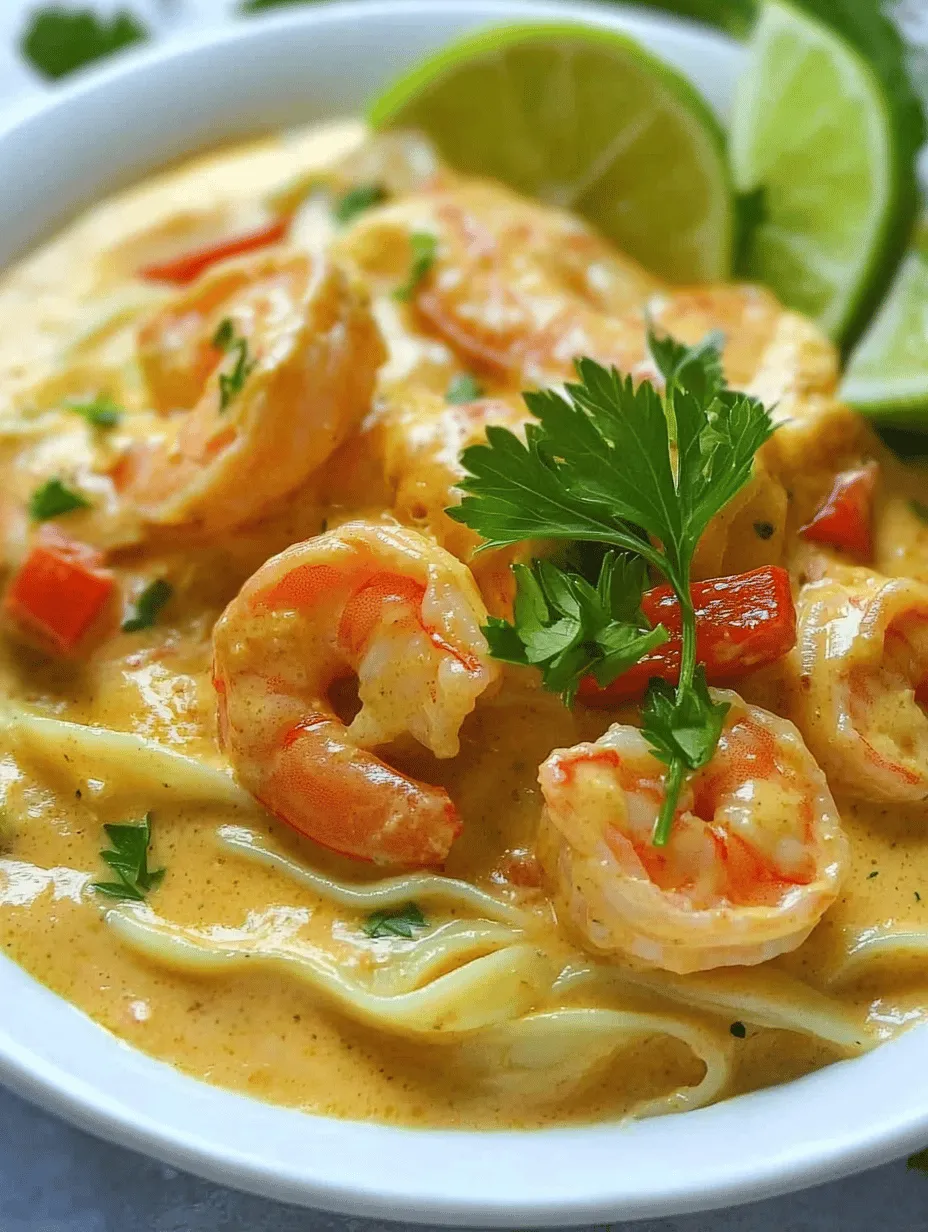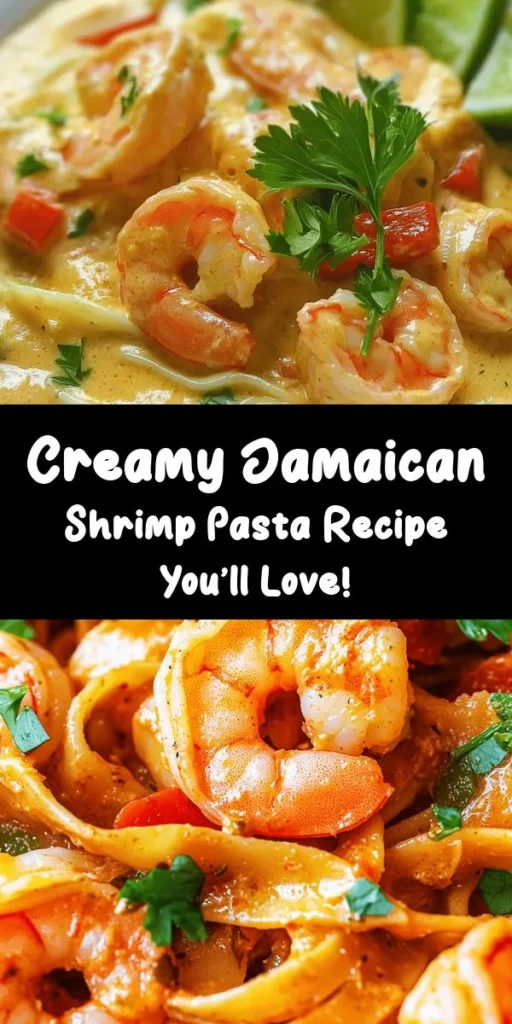Introduction to Jamaican Shrimp Pasta: A Creamy Delight
Jamaican cuisine is a vibrant tapestry of flavors influenced by its rich history and diverse cultures. The island’s culinary traditions are characterized by the use of fresh ingredients, bold spices, and a unique blend of techniques that reflect African, European, and indigenous Taíno influences. One of the most delightful manifestations of this culinary fusion is found in dishes like Jamaican Shrimp Pasta, which offers a tantalizing mix of Caribbean and Italian flavors that is both comforting and exhilarating.
Jamaican Shrimp Pasta stands out for its creamy texture and the way it incorporates unique ingredients that pay homage to the island’s culinary heritage. This dish combines the beloved elements of a classic pasta dish with the bold and aromatic flavors typical of Jamaican cooking. The result is a creamy delight that tantalizes the taste buds and transports you to a tropical paradise with each bite.
The importance of blending cultural influences in cooking cannot be overstated, especially when it comes to pasta dishes. Pasta, a staple in Italian cuisine, is versatile and pairs beautifully with various flavors from around the world. By incorporating Jamaican elements—such as shrimp, coconut milk, and spices—this dish showcases how culinary traditions can merge to create something truly special.
The Allure of Jamaican Shrimp Pasta
At the heart of Jamaican Shrimp Pasta is a delightful fusion of Caribbean and Italian flavors that captivates the palate. The dish elegantly combines the richness of a creamy pasta sauce with the freshness of shrimp, creating a meal that is both indulgent and satisfying. Shrimp, a popular ingredient in Jamaican cooking, plays a crucial role in this dish. Its sweet, briny flavor pairs perfectly with the other ingredients, adding depth and character to the overall dish.
The creamy sauce is made from a harmonious blend of coconut milk and heavy cream, which not only provides a luscious texture but also infuses the dish with a subtle tropical sweetness. This unique combination of ingredients sets Jamaican Shrimp Pasta apart from traditional pasta dishes, making it a standout option for anyone looking to explore new culinary horizons.
The allure of this dish lies not only in its flavor profile but also in its ability to transport you to the sun-soaked beaches of Jamaica. Imagine indulging in a plate of creamy shrimp pasta while listening to the gentle sounds of waves lapping against the shore. This dish embodies the essence of a tropical getaway, making it a perfect choice for special occasions or a simple weeknight dinner.
Ingredient Breakdown for Jamaican Shrimp Pasta
To create the perfect Jamaican Shrimp Pasta, it’s crucial to understand the role each ingredient plays in elevating the dish. Below is a detailed breakdown of the key components:
Pasta Varieties: Fettuccine vs. Linguine
The choice of pasta can significantly impact the final presentation and texture of your dish. For Jamaican Shrimp Pasta, both fettuccine and linguine work well, but they offer slightly different experiences. Fettuccine, with its wider, flat shape, holds onto the creamy sauce better, making each bite rich and flavorful. On the other hand, linguine is thinner and may provide a lighter mouthfeel. Ultimately, the choice between the two will depend on your personal preference and the texture you desire.
The Significance of Large Shrimp
Large shrimp are the stars of this dish, providing not only a satisfying bite but also a sweet and succulent flavor. When selecting shrimp, fresh or frozen options can be used, but it’s essential to choose high-quality shrimp that have been sustainably sourced. The size of the shrimp is also important; larger shrimp provide a more impressive presentation and a pleasing texture that complements the creamy sauce perfectly.
Aromatics: Onion, Garlic, and Bell Pepper for Depth of Flavor
Aromatic ingredients like onion, garlic, and bell pepper are essential for building a flavorful base for your pasta. Onions provide sweetness and depth, while garlic adds a robust aroma that elevates the dish. Bell peppers, particularly when using a mix of colors, contribute a subtle crunch and a hint of sweetness. Sautéing these aromatics before adding the shrimp will help to develop their flavors, creating a delicious foundation for the sauce.
Herbs and Spices: Thyme, Allspice, and Cayenne Pepper
The use of herbs and spices is what truly brings the essence of Jamaica into this dish. Fresh thyme is a staple in Jamaican cooking, imparting an earthy flavor that pairs beautifully with shrimp. Allspice, known for its unique warm flavor, adds complexity and authenticity to the dish. A touch of cayenne pepper brings a mild heat that balances the creaminess of the sauce, making each bite exciting and flavorful.
The Creamy Base: Coconut Milk and Heavy Cream
The creamy sauce is the hallmark of Jamaican Shrimp Pasta, blending coconut milk and heavy cream to create a luscious texture. Coconut milk, a staple in Caribbean cuisine, contributes a subtle sweetness and tropical flavor that complements the shrimp perfectly. Heavy cream adds richness and ensures that the sauce coats the pasta beautifully, resulting in a dish that is both indulgent and satisfying.
The Finishing Touch: Lime Juice for Brightness
To round out the flavors of Jamaican Shrimp Pasta, a splash of lime juice is essential. The acidity of lime juice acts as a bright counterpoint to the richness of the creamy sauce, enhancing the overall flavor profile and adding a refreshing zing. This finishing touch elevates the dish, making it feel vibrant and well-balanced.
Step-by-Step Instructions for Perfect Jamaican Shrimp Pasta
Now that we have a comprehensive understanding of the ingredients, it’s time to delve into the step-by-step instructions for creating the perfect Jamaican Shrimp Pasta.
Cooking the Pasta: Importance of Achieving Al Dente Texture
Start by bringing a large pot of salted water to a boil. It’s crucial to use enough salt to enhance the flavor of the pasta. Once the water is boiling, add your chosen pasta—be it fettuccine or linguine—and cook according to the package instructions until it reaches an al dente texture. Al dente means the pasta is cooked through but still has a slight firmness when bitten. This texture is important as it will continue to cook slightly when combined with the sauce, ensuring your pasta doesn’t become mushy.
Once the pasta is cooked, reserve a cup of the pasta water before draining. This starchy water can be added to the sauce later to adjust its consistency if needed, ensuring the perfect creamy coating for your pasta.
Sautéing the Aromatics: Techniques for Enhancing Flavors through Sautéing
While the pasta is cooking, it’s time to prepare the aromatics. In a large skillet, heat a couple of tablespoons of olive oil over medium heat. Once hot, add finely chopped onion and sauté until translucent, about 3-4 minutes. This process allows the onions to soften and release their natural sweetness.
Next, add minced garlic and diced bell pepper to the skillet, continuing to sauté for another 2-3 minutes. The key here is to allow the aromatics to cook gently, releasing their flavors without burning. Stir occasionally to ensure even cooking.
Preparing the Shrimp: Tips on Cooking Shrimp to Perfection Without Overcooking
Once the aromatics are fragrant and softened, it’s time to add the shrimp. Pat the shrimp dry with paper towels to ensure they sear properly and do not steam. Add the shrimp to the skillet in a single layer, ensuring not to overcrowd the pan. This step is critical for achieving that perfect golden-brown sear on the shrimp.
Cook the shrimp for about 2-3 minutes on each side until they turn pink and opaque. Take care not to overcook them, as shrimp can become rubbery if cooked for too long. Once the shrimp are cooked to perfection, remove them from the skillet and set them aside while you prepare the creamy sauce.
By following these initial steps, you lay the groundwork for a dish that beautifully marries the flavors of Jamaica with the comforting familiarity of pasta. Stay tuned for the next section, where we will delve into creating the creamy sauce and bringing this delightful dish together.

Making the Creamy Sauce
Creating the perfect creamy sauce is the heart of any successful pasta dish, and Jamaican Shrimp Pasta is no exception. The process begins by sautéing aromatics such as garlic, onion, and bell peppers in a generous amount of olive oil or butter. This step not only builds a flavorful base but also allows the natural sweetness of the vegetables to emerge.
Once the aromatics are softened and fragrant, it’s time to add the star of the show—coconut milk. This ingredient is key to achieving a creamy texture while infusing the dish with a distinct tropical flavor. To thicken the sauce, maintain a gentle simmer after adding the coconut milk, allowing it to reduce slightly. You can also incorporate a splash of chicken or vegetable broth to enhance the flavor depth.
For an added layer of taste, consider stirring in a tablespoon of cornstarch mixed with water. This slurry will help to thicken the sauce without altering its flavor profile. Remember to stir continuously to prevent lumps and ensure a smooth consistency. Season the sauce with salt, pepper, and a hint of lime juice for brightness. As the sauce thickens, the richness will coat the shrimp and pasta beautifully, creating a luscious mouthfeel.
Combining Pasta and Sauce
Once your pasta is cooked al dente, it’s time to unite the elements of this delightful dish. Drain the pasta, reserving a cup of the starchy cooking water. This water is a secret weapon when it comes to marrying the pasta and sauce, as it helps create a cohesive dish.
Add the cooked pasta directly into the creamy sauce while it’s still on low heat. Toss gently but thoroughly to ensure every strand is well-coated. If the sauce appears too thick, gradually add the reserved pasta water until you achieve the desired consistency. This technique not only aids in the coating process but also helps the sauce cling to the pasta more effectively.
To enhance the flavor profile, fold in your sautéed shrimp at this stage, allowing them to warm up in the sauce for a minute or two. Be careful not to overcook the shrimp, as they can become rubbery. The goal is to create a harmonious blend of flavors where the shrimp, pasta, and sauce complement each other beautifully.
Serving and Garnishing
Presentation is key when it comes to serving Jamaican Shrimp Pasta, as it enhances the overall dining experience. Start by plating the pasta in a large, shallow bowl or on a plate, allowing the creamy sauce to cascade over the pasta.
For a visual pop, garnish with freshly chopped parsley or cilantro, which adds a burst of color and freshness. A sprinkle of red pepper flakes can introduce a hint of spice and vibrant color, while zesting a lime over the dish adds a zingy aroma.
To elevate the culinary experience further, consider serving the dish with a side of crusty bread or a light salad dressed with a tangy vinaigrette. This not only complements the pasta but also adds a delightful crunch or acidity to balance the creamy sauce.
Nutritional Benefits of Jamaican Shrimp Pasta
Jamaican Shrimp Pasta is not just a feast for the senses; it also boasts a range of nutritional benefits.
1. Overview of the Nutritional Components: This dish is a balanced meal, combining protein from shrimp, healthy fats from coconut milk, and carbohydrates from pasta. Additionally, the inclusion of various vegetables contributes essential vitamins and minerals.
2. Health Benefits of Shrimp: Shrimp is a low-calorie seafood option rich in protein, making it an excellent choice for those watching their caloric intake while seeking to build or maintain muscle mass. Furthermore, shrimp is a good source of omega-3 fatty acids, which are beneficial for heart health.
3. Benefits of Coconut Milk: As a dairy alternative, coconut milk provides creamy texture and flavor without the lactose. It is rich in medium-chain triglycerides (MCTs), which are known to promote fat loss and improve energy levels. Moreover, coconut milk contains important nutrients such as iron, magnesium, and potassium.
4. The Value of Vegetables: The vegetables used in Jamaican Shrimp Pasta, such as bell peppers and onions, contribute essential vitamins (like vitamin C and A) and fiber, which aids in digestion and promotes overall health.
Cultural Significance of Jamaican Cuisine
Jamaican cuisine is a vibrant tapestry woven from the influences of various cultures. The roots of this cooking style are deeply embedded in the island’s history, reflecting its indigenous Taino heritage, African traditions, and European colonial influences.
1. Discussion on the Roots of Jamaican Cooking: Traditional Jamaican cooking showcases bold flavors and spices, often employing techniques such as jerk seasoning, which highlights the fusion of cultural influences. The use of fresh, local ingredients makes Jamaican dishes not only flavorful but also sustainable.
2. The Fusion of Various Cultures in Jamaican Food: The culinary landscape of Jamaica is a melting pot, with influences from Indian, Chinese, and British cuisines. This fusion is evident in dishes like curry goat, chow mein, and even the iconic ackee and saltfish, showcasing the adaptability and creativity of Jamaican cooks.
3. How Jamaican Shrimp Pasta Represents the Diversity of Caribbean Cuisine: Jamaican Shrimp Pasta is a prime example of how traditional Jamaican flavors can be reimagined in contemporary dishes. It highlights the adaptability of Caribbean cuisine while still paying homage to its roots. The combination of shrimp, coconut milk, and spices reflects the island’s rich culinary heritage, making it a dish that celebrates the cultural diversity of the Caribbean.
Creative Variations on Jamaican Shrimp Pasta
One of the joys of cooking is the ability to personalize recipes to suit your tastes and dietary preferences. Jamaican Shrimp Pasta is no exception, offering various avenues for creativity.
1. Suggestions for Ingredient Substitutions: While traditional pasta works wonderfully, consider experimenting with whole grain or gluten-free pasta for a healthier option. You can also add leafy greens such as spinach or kale for an extra nutrient boost.
2. Alternate Protein Options: If shrimp is not your preference, chicken or plant-based alternatives like tofu or tempeh can easily be swapped in. Simply adjust the cooking time accordingly to ensure these proteins are cooked through.
3. Exploring Flavor Variations: Feel free to customize the spices and herbs to match your palate. For a spicier kick, add more Scotch bonnet pepper or hot sauce. For a milder flavor, use simple herbs like basil or thyme, which will lend a different yet equally delightful taste to the dish.
Conclusion: Savoring the Creamy Delight of Jamaican Shrimp Pasta
In conclusion, Jamaican Shrimp Pasta is more than just a meal; it’s a celebration of flavors, culture, and creativity. The creamy sauce enveloping tender shrimp and perfectly cooked pasta creates a dish that is both satisfying and indulgent.
This recipe not only brings a taste of the Caribbean to your table but also allows you to explore and express your culinary creativity. Whether you stick to the traditional ingredients or venture into personal adaptations, each bite is a reminder of the vibrant culture and history of Jamaican cuisine.
Encourage yourself to experiment with this recipe, embracing the joy of cooking and the satisfaction that comes from creating a delicious meal. As you savor the creamy delight of Jamaican Shrimp Pasta, you’ll find that it has the power to transport you to sun-soaked shores, no matter where you are.



